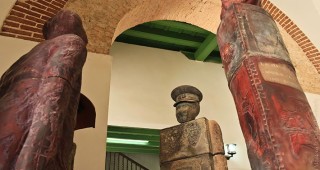The Museum of Mural Painting exhibits some beautifully restored original frescoes in one of the oldest surviving houses in the city, owned by Antón Recio, important figure of 16th-century Havana.
Opening hours: 9:30 am-5pm Tues-Sat; 9:30am-1pm Sun
The Museum of Mural Painting exhibits some beautifully restored original frescoes in one of the oldest surviving houses in the city, owned by Antón Recio, important figure of 16th-century Havana.
Opening hours: 9:30 am-5pm Tues-Sat; 9:30am-1pm Sun

 2
2The Institute of Secondary Education of Havana was founded in 1863 and originally located on Calle Obispo. It was later moved to this site in 1924 as part of the construction program for the area in t …
 EclecticAdmission: n-aZulueta e/ San José y Teniente Rey, Habana Vieja
EclecticAdmission: n-aZulueta e/ San José y Teniente Rey, Habana Vieja 
 2
2This 1941 building repeats the structure of lines that emphasize verticality and includes a small two story-tower. Initially known as the Rodríguez Vázquez Building, it included two cinemas, a café-re …
 Art DecoGaliano entre Neptuno y Concordia
Art DecoGaliano entre Neptuno y Concordia 
 2
2Created by, and housed in the headquarters of, the Asociación Cultural Yoruba de Cuba, this museum is dedicated to santería and features sculptures representing the different Afro-Cuban orishas (saint …

 2
2The Museo Armería 9 de Abril displays a large collection of firearms and bladed weapons spanning the 18th to the 20th centuries. It occupies the former Compañía Armera de Cuba, a private gun shop that …

 2
2Housed within Casa de Francisco Aguilera Basabe, a two-story building built in 1728, this museum exhibits Cuban art pottery from 1950 to the present day on the top floor, while the ground floor has a …
 ColonialAdmission: FreeOpen: 9am-5pm Tues-SunMercaderes esq. a Amargura, Habana Vieja
ColonialAdmission: FreeOpen: 9am-5pm Tues-SunMercaderes esq. a Amargura, Habana Vieja 
 2
2The Fuente de Neptuno (Fountain of Neptune) was imported from Italy. Besides its ornamental function, it also supplied water to three boats at the same time, for which large iron rings were placed for …

 2
2This quaint and lovely shop sells perfumes from the Cuban Suchel brand, and prepares personalized fragrances on site according to patrons’ tastes. It also doubles as a small museum, with a 19th-centur …

 2
2First called Cementerio General de La Habana, the Cementerio de Espada was built after the Spanish authorities issued a Royal Edict banning burials in temples because it was considered unhygienic. The …

 2
2By the 1700s, Havana boasted an artillery factory for the manufacture and repair of weapons and ammunition. The factory was demolished and a “castle” was the built for the Police. This archeological s …

 2
2This street was built by order of Governor Miguel de Tacón in 1836 and connects the intersection of Reina and Belascoaín streets to the Castillo del Príncipe. It was originally named Paseo de Tacón. L …